transmission oil VOLVO V90 CROSS COUNTRY 2017 Owner´s Manual
[x] Cancel search | Manufacturer: VOLVO, Model Year: 2017, Model line: V90 CROSS COUNTRY, Model: VOLVO V90 CROSS COUNTRY 2017Pages: 552, PDF Size: 13.6 MB
Page 13 of 552
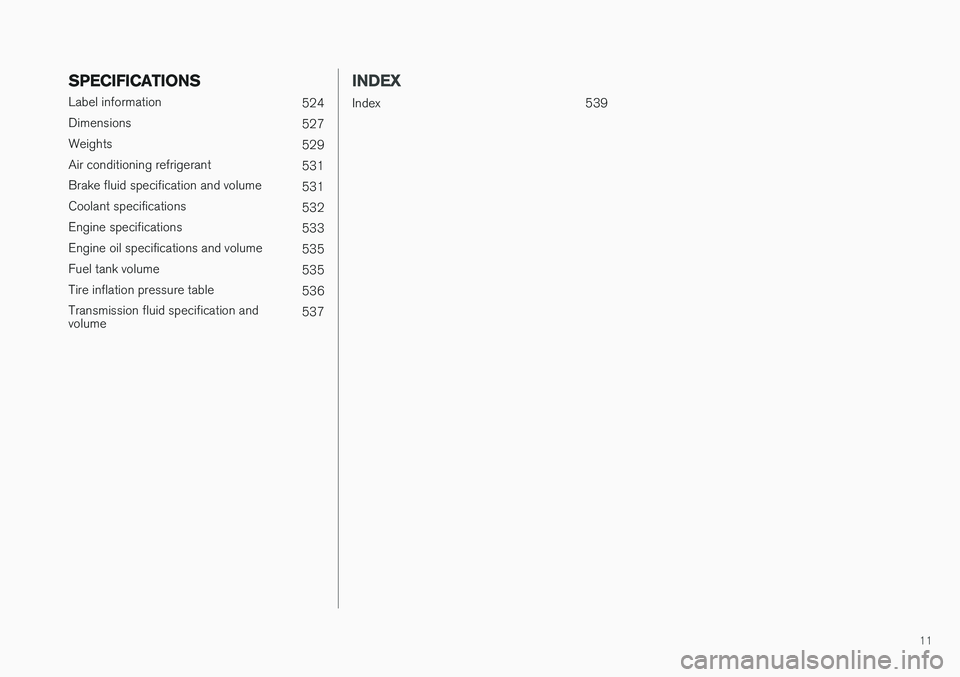
11
SPECIFICATIONS
Label information524
Dimensions 527
Weights 529
Air conditioning refrigerant 531
Brake fluid specification and volume 531
Coolant specifications 532
Engine specifications 533
Engine oil specifications and volume 535
Fuel tank volume 535
Tire inflation pressure table 536
Transmission fluid specification and volume 537
INDEX
Index 539
Page 360 of 552
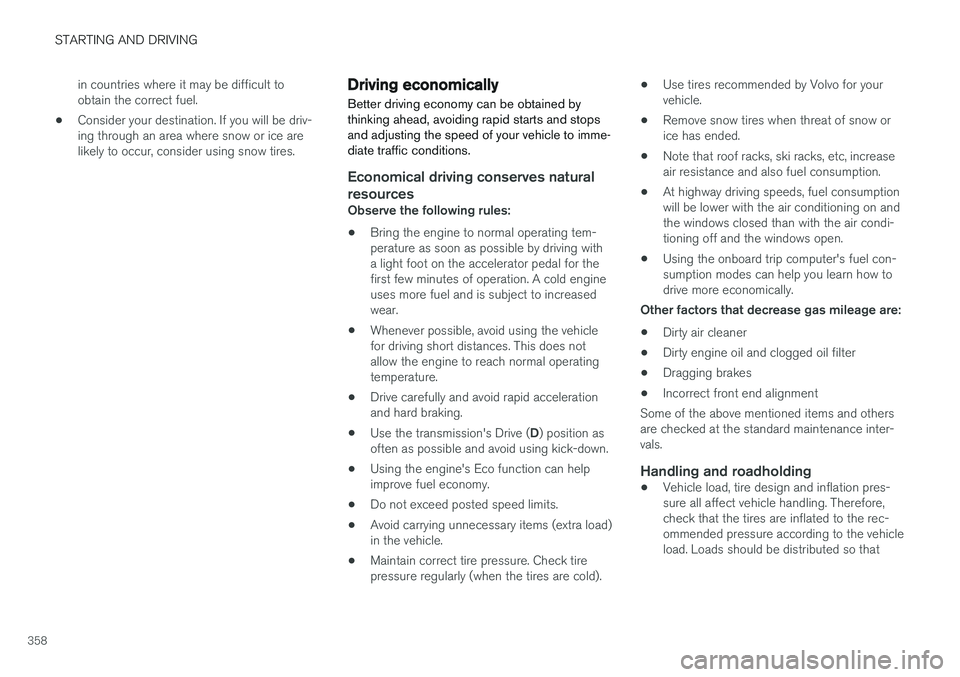
STARTING AND DRIVING
358in countries where it may be difficult to obtain the correct fuel.
• Consider your destination. If you will be driv-ing through an area where snow or ice arelikely to occur, consider using snow tires.
Driving economically
Better driving economy can be obtained by thinking ahead, avoiding rapid starts and stopsand adjusting the speed of your vehicle to imme-diate traffic conditions.
Economical driving conserves natural resources
Observe the following rules: • Bring the engine to normal operating tem- perature as soon as possible by driving witha light foot on the accelerator pedal for thefirst few minutes of operation. A cold engineuses more fuel and is subject to increasedwear.
• Whenever possible, avoid using the vehiclefor driving short distances. This does notallow the engine to reach normal operatingtemperature.
• Drive carefully and avoid rapid accelerationand hard braking.
• Use the transmission's Drive (
D) position as
often as possible and avoid using kick-down.
• Using the engine's Eco function can helpimprove fuel economy.
• Do not exceed posted speed limits.
• Avoid carrying unnecessary items (extra load)in the vehicle.
• Maintain correct tire pressure. Check tirepressure regularly (when the tires are cold). •
Use tires recommended by Volvo for yourvehicle.
• Remove snow tires when threat of snow orice has ended.
• Note that roof racks, ski racks, etc, increaseair resistance and also fuel consumption.
• At highway driving speeds, fuel consumptionwill be lower with the air conditioning on andthe windows closed than with the air condi-tioning off and the windows open.
• Using the onboard trip computer's fuel con-sumption modes can help you learn how todrive more economically.
Other factors that decrease gas mileage are:
• Dirty air cleaner
• Dirty engine oil and clogged oil filter
• Dragging brakes
• Incorrect front end alignment
Some of the above mentioned items and othersare checked at the standard maintenance inter-vals.
Handling and roadholding
• Vehicle load, tire design and inflation pres-sure all affect vehicle handling. Therefore,check that the tires are inflated to the rec-ommended pressure according to the vehicleload. Loads should be distributed so that
Page 361 of 552
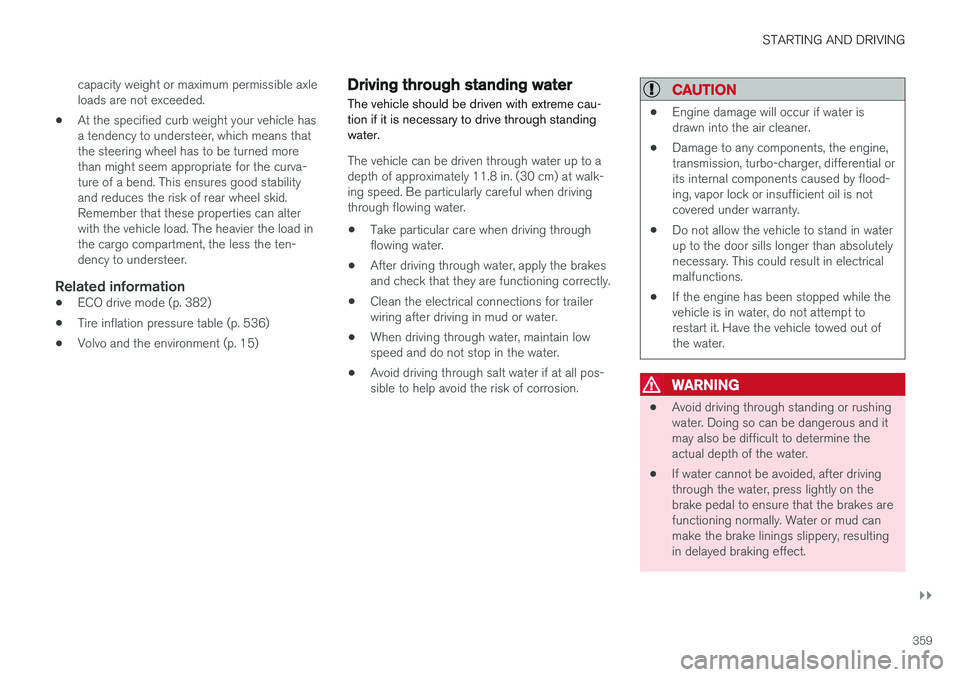
STARTING AND DRIVING
}}
359
capacity weight or maximum permissible axle loads are not exceeded.
• At the specified curb weight your vehicle hasa tendency to understeer, which means thatthe steering wheel has to be turned morethan might seem appropriate for the curva-ture of a bend. This ensures good stabilityand reduces the risk of rear wheel skid.Remember that these properties can alterwith the vehicle load. The heavier the load inthe cargo compartment, the less the ten-dency to understeer.
Related information
•ECO drive mode (p. 382)
• Tire inflation pressure table (p. 536)
• Volvo and the environment (p. 15)
Driving through standing water
The vehicle should be driven with extreme cau- tion if it is necessary to drive through standingwater.
The vehicle can be driven through water up to a depth of approximately 11.8 in. (30 cm) at walk-ing speed. Be particularly careful when drivingthrough flowing water. • Take particular care when driving through flowing water.
• After driving through water, apply the brakesand check that they are functioning correctly.
• Clean the electrical connections for trailerwiring after driving in mud or water.
• When driving through water, maintain lowspeed and do not stop in the water.
• Avoid driving through salt water if at all pos-sible to help avoid the risk of corrosion.
CAUTION
• Engine damage will occur if water is drawn into the air cleaner.
• Damage to any components, the engine,transmission, turbo-charger, differential orits internal components caused by flood-ing, vapor lock or insufficient oil is notcovered under warranty.
• Do not allow the vehicle to stand in waterup to the door sills longer than absolutelynecessary. This could result in electricalmalfunctions.
• If the engine has been stopped while thevehicle is in water, do not attempt torestart it. Have the vehicle towed out ofthe water.
WARNING
•
Avoid driving through standing or rushing water. Doing so can be dangerous and itmay also be difficult to determine theactual depth of the water.
• If water cannot be avoided, after drivingthrough the water, press lightly on thebrake pedal to ensure that the brakes arefunctioning normally. Water or mud canmake the brake linings slippery, resultingin delayed braking effect.
Page 381 of 552
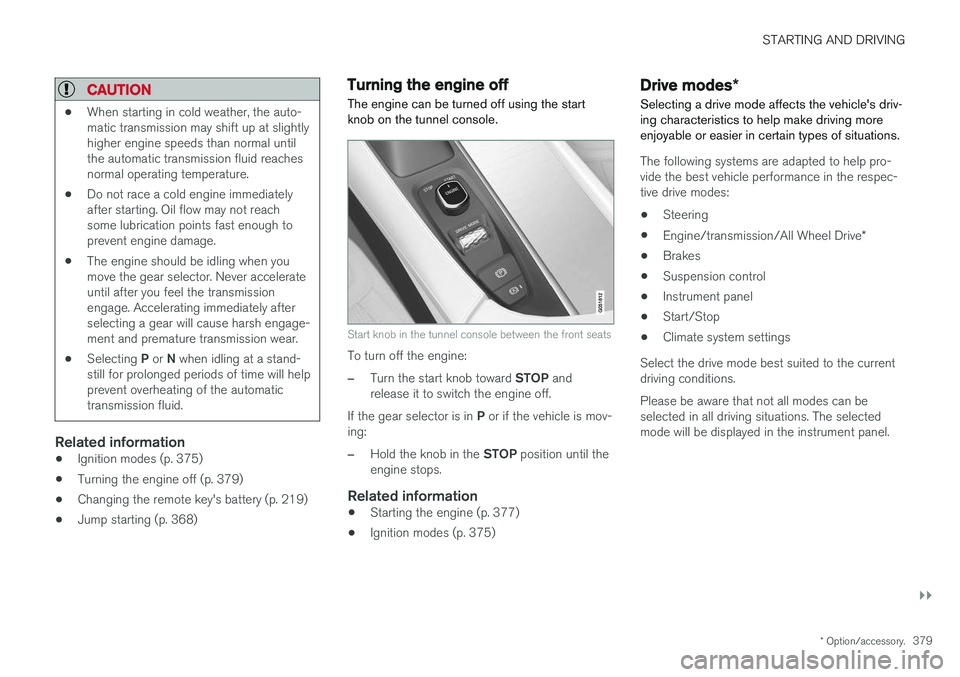
STARTING AND DRIVING
}}
* Option/accessory.379
CAUTION
•When starting in cold weather, the auto- matic transmission may shift up at slightlyhigher engine speeds than normal untilthe automatic transmission fluid reachesnormal operating temperature.
• Do not race a cold engine immediatelyafter starting. Oil flow may not reachsome lubrication points fast enough toprevent engine damage.
• The engine should be idling when youmove the gear selector. Never accelerateuntil after you feel the transmissionengage. Accelerating immediately afterselecting a gear will cause harsh engage-ment and premature transmission wear.
• Selecting
P or N when idling at a stand-
still for prolonged periods of time will helpprevent overheating of the automatictransmission fluid.
Related information
• Ignition modes (p. 375)
• Turning the engine off (p. 379)
• Changing the remote key's battery (p. 219)
• Jump starting (p. 368)
Turning the engine off
The engine can be turned off using the start knob on the tunnel console.
Start knob in the tunnel console between the front seats
To turn off the engine:
–Turn the start knob toward STOP and
release it to switch the engine off.
If the gear selector is in P or if the vehicle is mov-
ing:
–Hold the knob in the STOP position until the
engine stops.
Related information
• Starting the engine (p. 377)
• Ignition modes (p. 375)
Drive modes
*
Selecting a drive mode affects the vehicle's driv- ing characteristics to help make driving moreenjoyable or easier in certain types of situations.
The following systems are adapted to help pro- vide the best vehicle performance in the respec-tive drive modes: • Steering
• Engine/transmission/All Wheel Drive
*
• Brakes
• Suspension control
• Instrument panel
• Start/Stop
• Climate system settings
Select the drive mode best suited to the current driving conditions. Please be aware that not all modes can be selected in all driving situations. The selectedmode will be displayed in the instrument panel.
Page 491 of 552
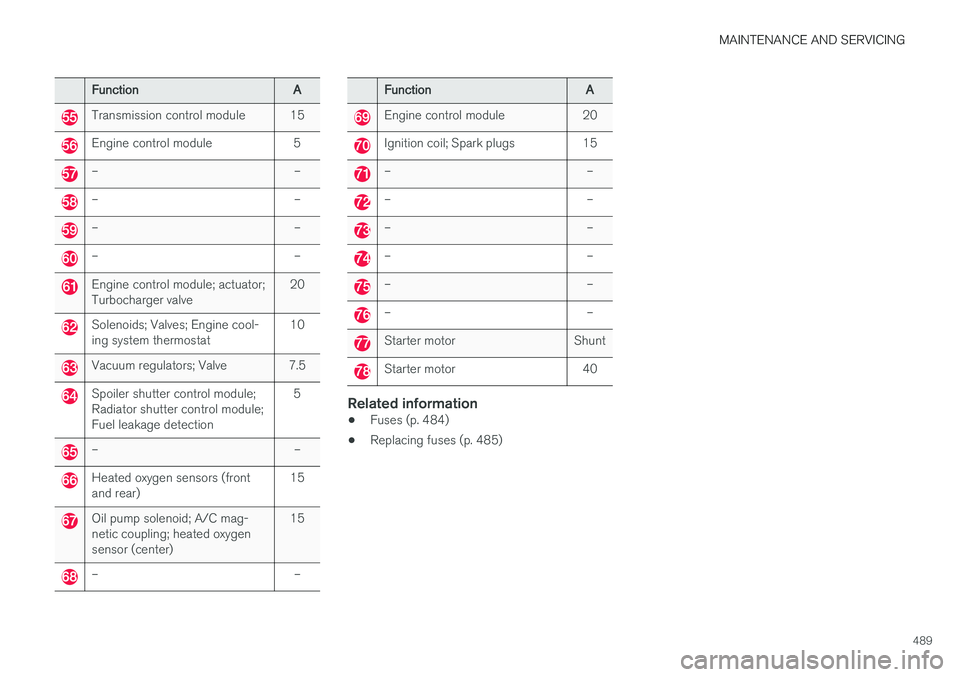
MAINTENANCE AND SERVICING
489
FunctionA
Transmission control module 15
Engine control module 5
– –
– –
– –
– –
Engine control module; actuator; Turbocharger valve20
Solenoids; Valves; Engine cool- ing system thermostat10
Vacuum regulators; Valve 7.5
Spoiler shutter control module; Radiator shutter control module;Fuel leakage detection 5
– –
Heated oxygen sensors (front and rear)
15
Oil pump solenoid; A/C mag- netic coupling; heated oxygensensor (center)15
– –
Function
A
Engine control module 20
Ignition coil; Spark plugs 15
– –
– –
– –
– –
– –
– –
Starter motor Shunt
Starter motor 40
Related information
•Fuses (p. 484)
• Replacing fuses (p. 485)
Page 549 of 552
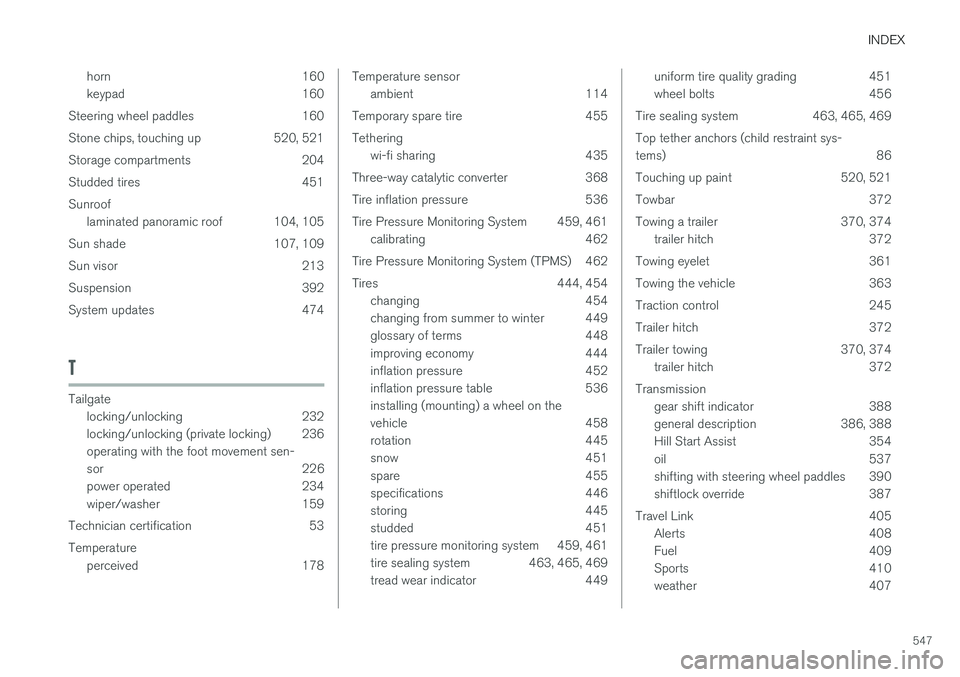
INDEX
547
horn 160
keypad 160
Steering wheel paddles 160
Stone chips, touching up 520, 521
Storage compartments 204
Studded tires 451Sunroof laminated panoramic roof 104, 105
Sun shade 107, 109
Sun visor 213
Suspension 392
System updates 474
T
Tailgate locking/unlocking 232
locking/unlocking (private locking) 236operating with the foot movement sen-
sor 226
power operated 234
wiper/washer 159
Technician certification 53 Temperature perceived 178
Temperature sensorambient 114
Temporary spare tire 455 Tethering wi-fi sharing 435
Three-way catalytic converter 368
Tire inflation pressure 536
Tire Pressure Monitoring System 459, 461 calibrating 462
Tire Pressure Monitoring System (TPMS) 462
Tires 444, 454 changing 454
changing from summer to winter 449
glossary of terms 448
improving economy 444
inflation pressure 452
inflation pressure table 536installing (mounting) a wheel on the
vehicle 458
rotation 445
snow 451
spare 455
specifications 446
storing 445
studded 451
tire pressure monitoring system 459, 461
tire sealing system 463, 465, 469
tread wear indicator 449uniform tire quality grading 451
wheel bolts 456
Tire sealing system 463, 465, 469 Top tether anchors (child restraint sys- tems) 86
Touching up paint 520, 521
Towbar 372
Towing a trailer 370, 374 trailer hitch 372
Towing eyelet 361
Towing the vehicle 363
Traction control 245
Trailer hitch 372
Trailer towing 370, 374 trailer hitch 372
Transmission gear shift indicator 388
general description 386, 388
Hill Start Assist 354
oil 537
shifting with steering wheel paddles 390
shiftlock override 387
Travel Link 405 Alerts 408
Fuel 409
Sports 410
weather 407